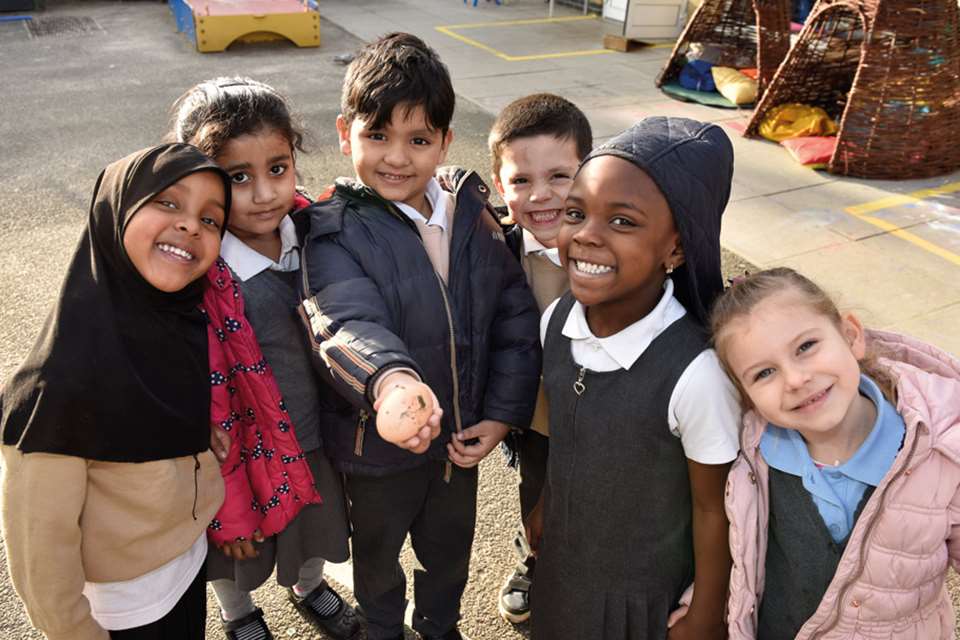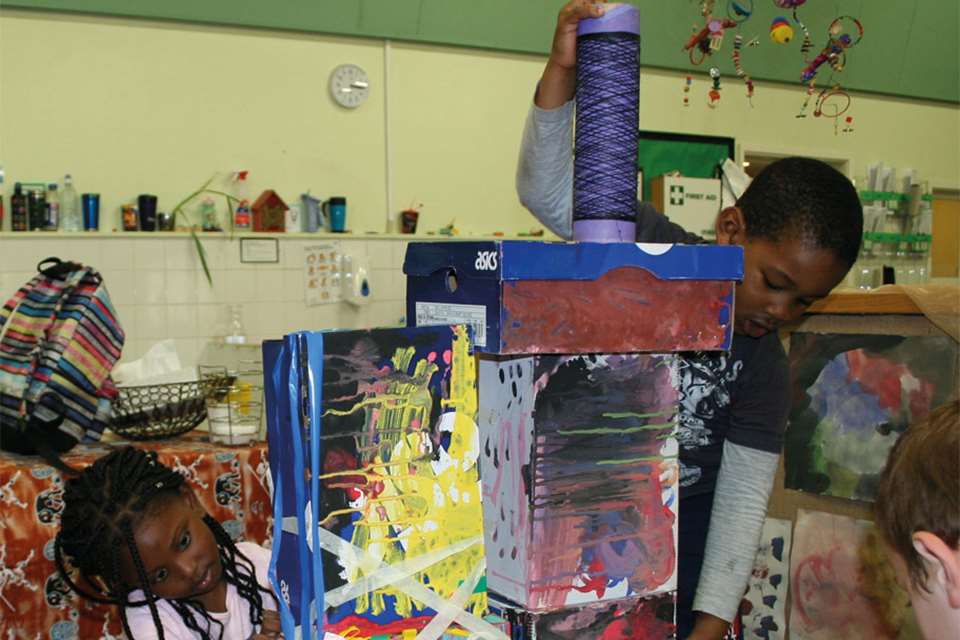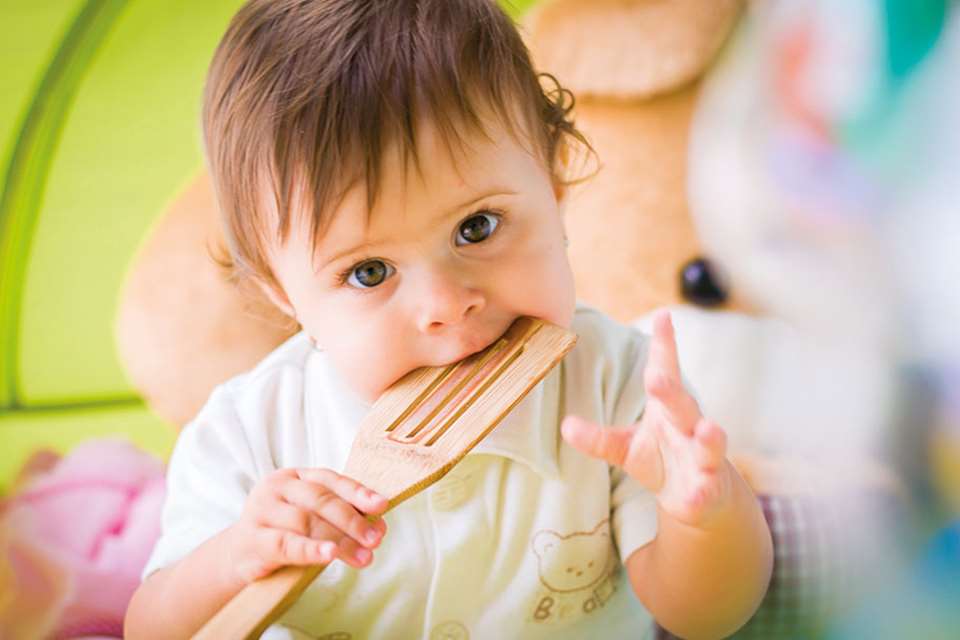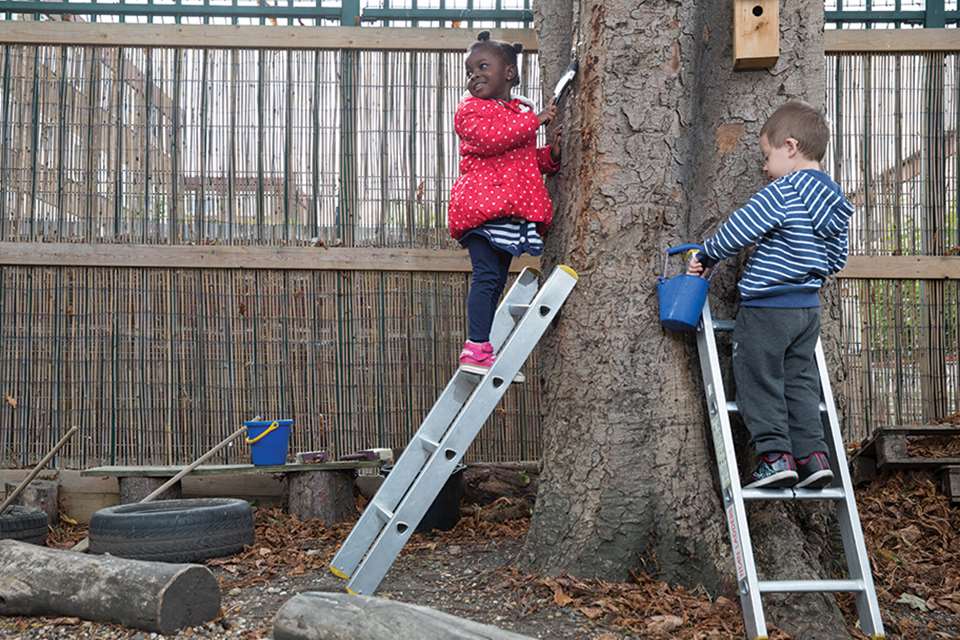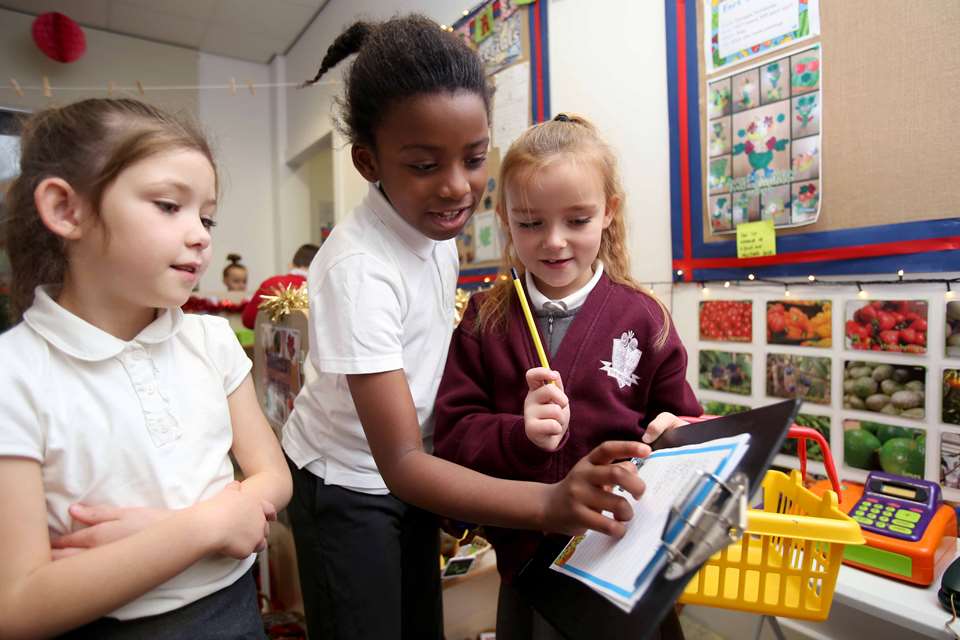Learning & Development: Play - Master minds
Annette Rawstrone
Monday, May 29, 2017
An artist’s residency at one setting led to loose-parts play, and to practitioners questioning their role and the meaning of early education. By Annette Rawstrone
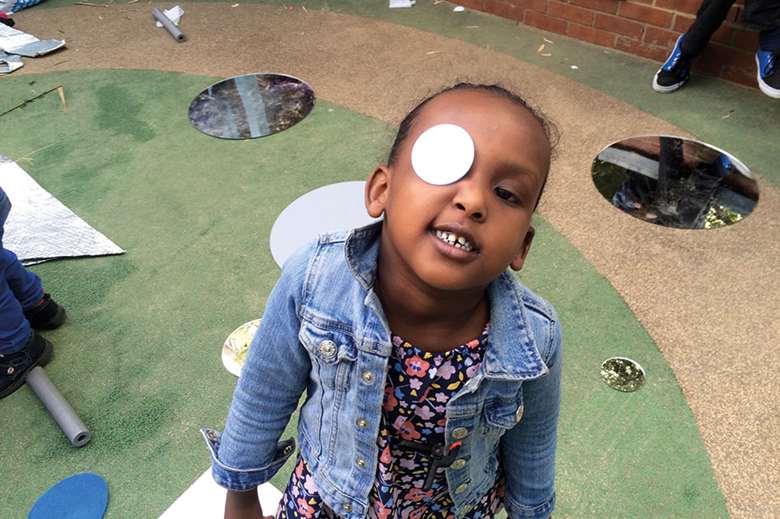
What started as an interesting art project exploring the values and possibilities of free play at the Portman Early Childhood Centre in London escalated into practitioners scrutinising, questioning and re-evaluating their own practice.
When artist Albert Potrony took up residence at the Westminster nursery for 12 weekly sessions last year, commissioned by Serpentine Galleries (see box), he cleared an area free from toys and introduced the three- and four-year-olds to a kit of loose parts, including transparent sheets, reflective rolls, foam tubes, circles and triangles sourced from DIY shops and scrap stores. ‘I started with materials that I thought were interesting but that are cheap and widely available with the aim of seeing how the children responded to them and their environment,’ explains Mr Potrony.
He deliberately chose large, non-specific materials so that the children would collaborate and use them in varied ways. Importantly, the practitioners were instructed not to interrupt or guide play so that the children used and adapted the materials and developed their own lines of enquiry.
‘I wanted it to be the children who came up with the ideas and be creative, which they were. The more that they got familiar with the resources then the better solutions they found,’ he adds.
Mr Potrony believes that there is a need for us to create spaces where children are free to explore in their own way so that they are in charge of their explorations and can assert their power as individuals. ‘There needs to be places where they can decide their own learning – what and how they want to learn,’ he says. ‘It reinforces the fact that children can come up with solutions rather than being given them.’
The children used corrugated plastic sheeting to create space rockets and dens, mirrors became stepping stones, triangular foam transformed into horses or building materials, and pieces of cord and small clips were used to tie up and fasten on to the staff – ‘The adults became not a collaborator but a material,’ Mr Potrony comments.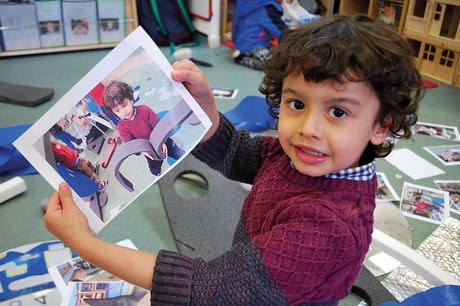
CREATIVE AND COMMITTED
After each session, the nursery staff met with the artist to review it. These meetings became as rich and varied as the children’s explorations and sparked many debates to the extent that the discussions became a large part of the project. Senior teacher Cathy Palser recalls, ‘In the meetings, we had real pedagogical arguments – if it’s better not to interact with the children then why are we here? If education is about children’s self-discovery, then how does that relate to the British school system? How is teacher training affected? Are we too language-based in our practice? Is education just a training system for work? Is it best to explore or to be told? It was interesting to hear everyone’s opinions because we have a range of staff from different countries and training backgrounds.’
Mr Potrony was awed by how passionate the practitioners were in their discussions and ‘how deeply they felt the issues’. He was initially surprised that they agreed to clear out the toys and then that some staff continued to do this outside of the sessions. ‘The children became inventors, they created stories and played with the things that they found. They flew with their own ideas and own enquiries,’ he says. ‘This was all initiated by the project, but the staff pushed it even further than I expected. I was excited to see how the staff were so creative and committed to try things.’
Putting out no or very limited resources divided the nursery staff. ‘Some of us hated it whereas some loved it,’ says Ms Palser. ‘I felt that the children interacted more and had nothing to compete about. Others felt that the children were not stimulated enough or some children were doing nothing – but what is doing nothing and what is looking at an ant?’
She believes that the sessions without toys enabled the children to engage in different ways – lots of singing, chanting and big group work. ‘The dynamic was different,’ she reflects. ‘I’d encourage any nursery to try it for an afternoon and see how the children behave completely differently. This form of play may suit some children and not others, but the same can be said for certain toys.’
Some staff argued that the sessions were not preparing children for school, others counteracted that nursery’s role should be to produce confident children. This led to a discussion about what education is.
On reflection, staff realised that many areas of the EYFS were covered during the sessions – shape, space, working with others and problem-solving. ‘It made us work really hard to assess the learning for the children’s Learning Journeys because it was not language-based,’ says Ms Palser. ‘But an ability to articulate does not necessarily demonstrate a child’s maths knowledge – by throwing a ball into a bucket they have worked out the angle and velocity and not actually had to say anything.’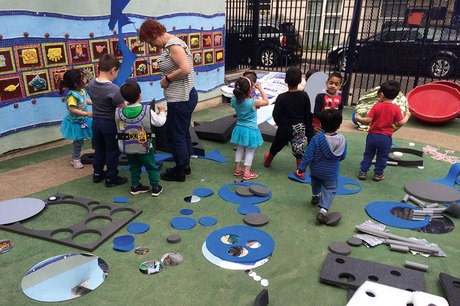
PATTERNS OF INTERACTING
The rule of not interrupting or guiding the children was to stop staff taking a child on a different direction, but Ms Palser says it ‘nearly killed us and went against all our training’.
Mr Potrony argues, ‘As adults we can close things up just by asking a question that we don’t think has any weight, such as “what are you making?”. This forces children to decide what it is when they may be just exploring. It’s important to let children be masters of their own play.’
Ms Palser admits to continuing to struggle with this concept, even though she understands the theory. ‘We have a pattern of interacting with the children and are good at it, but it’s not necessarily right for all children. I found this very hard as a practitioner because I’m trained to elicit language, and we have a lot of EAL children so we are even more alert to encouraging language,’ she says.
‘If we’re not there to ask questions then what is our role? Are we just there to make sure that no-one has an accident?’
Staff noticed that many children with special needs accessed the area well. ‘An autistic child who is non-verbal would go to the activity every week and really engage with the materials. I think that not having a practitioner saying well done or asking him what he had made helped him to engage,’ says Ms Palser. ‘He could be as social or as unsocial as he liked. He could act as a robot by himself or in someone else’s play, but it left us with a massive dilemma – how can he gain language if we’re not interacting and asking him to say what he’s doing?’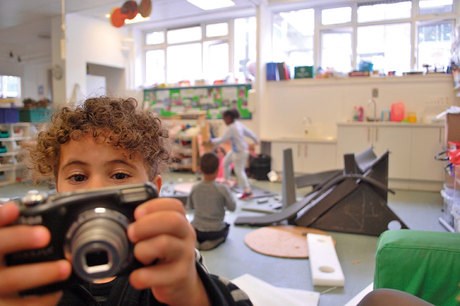
RESPECT AND FREEDOM
Children were allowed to use the materials as they chose, cutting and adapting them at will. ‘I was ripping stuff and I like it!’ remarked one boy. In the first session, three huge cardboard sheets deemed too big were put to one side, but a child started to hammer the card and then others joined in. ‘There was amazing energy and the adults started to hold the card to make sure that it was safe while the children unleashed their momentum – I call it a wildfire moment – and then it disappeared again,’ describes Mr Potrony.
This sparked more debate between the staff and artist because some practitioners felt that it was teaching children that they could do what they liked with a resource and questioned whether that was correct. ‘Is it seen as creativity and artistic when children are allowed to do what they want? It’s a dilemma that can be debated all sorts of ways and never resolved,’ says Ms Palser. ‘We want children to respect resources but have the freedom to explore – not staff saying don’t cut that, don’t put it in the water. At the same time, children need to know that not everything is disposable.’
A linked issue was whether play is about rules and whether play needs rules. ‘We’re based in one of the most deprived wards and many of the children are in constant flux with housing changes, parents in stress and no rules or boundaries,’ Ms Palser says. ‘Perhaps our children need rules, whereas perhaps other children would benefit from having no rules.’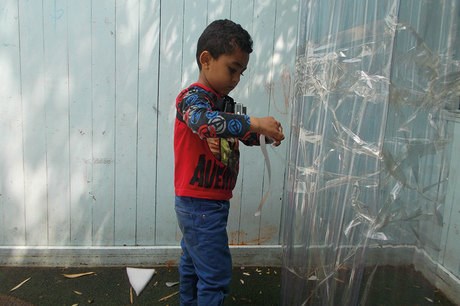
EATING BRAINS
The project was documented with photographs taken by the practitioners, artist and children. Children also filmed what they were doing with GoPro action cameras attached to their bodies. ‘It was great that we could see what was going on in the hidden spaces and dark alcoves,’ reflects Ms Palser. ‘There is a lovely piece of film with a boy with a torch carefully exploring a hole in the wall in a dark den. It was really interesting to see how the children play when there is no adult there.’
Towards the end of the residency Mr Potrony shared the photos with the children and they told stories about what they were doing, how they were ‘making cake’ out of piled up foam and mirrors and pretending to be robots eating brains – not activities that the staff would have instigated. One child, looking at photos of wrapping a girl in corrugated sheet and Sellotape, recalled, ‘We tangling Alexandra. She’s in jail. She did something wrong… I was building a waterfall and she was inside it like a house.’
‘Without the weekly discussions, we could have just thought it was chaos,’ says Ms Palser. ‘I still need to remind myself, because of all my training about scaffolding, planning resources and having equipment ready, to trust in the children.
‘I really believe that they were learning through their play, and removing the toys made me see their actual play. Until we’d done it, I wouldn’t have believed that there could be an end product.’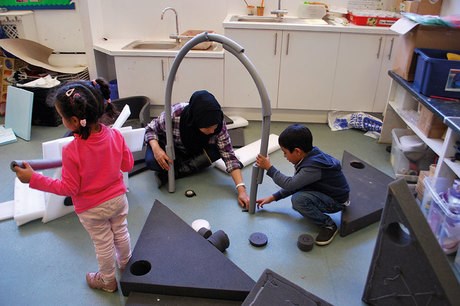
CHANGING PLAY
Children being pulled across the grass on a length of shiny material confronted some visitors to the Serpentine Galleries in London. Others could be seen putting clips on trees or piling loose parts in an Early Years Atelier set up to further explore artist Albert Potrony’s work.
The atelier, in a room opening into the park, was open for a week to enable children from other early years settings to explore the open-ended materials. ‘Every day has been something new depending on the children’s interests,’ says education curator Alex Thorp. ‘It’s been very different from the Portman because of the space and connection with nature. Children start to take the materials outside and then play on a much bigger scale. One group used the indoors as a store room, grabbed what they wanted and took it outside.’
The atelier is the culmination of Mr Potrony’s residency, which is part of the ongoing Changing Play partnership between the Serpentine Galleries and the Portman. Since 2014 it has been bringing together artists, children, families and educators to reconsider the role of play in early years education. Ms Thorp says that the programme aims to celebrate existing practices and generate new alternatives at a time when there is a more outcome-driven focus in schools, with early years practitioners feeling the pressure to follow a curriculum and work towards children being ‘school ready’.
Mr Potrony has used documentation of the Portman children’s experiences, discussions with parents and the ensuing staff debates to compile a ‘Play as Radical Practice’ toolkit for practitioners with the aim of opening up pedagogical conversations in other settings. ‘I wanted it to encompass all the voices, have a function and be a tool for discussion and share practice with other institutions,’ he says.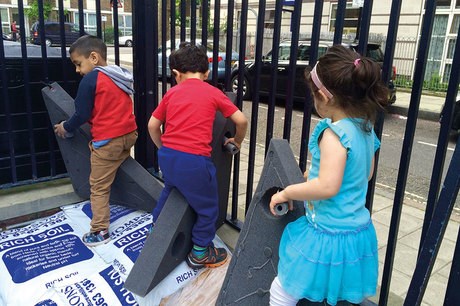
PARENTS’ PERSPECTIVE
During the residency there were three parents’ sessions to discuss the project and explore their attitudes to play. The parents originate from many countries, but they all felt that their children have less freedom than they enjoyed when young. ‘A lot of families are fearful and don’t let their children play in the streets,’ says Ms Palser. ‘They play in organised events, such as with their mother in the park instead of having freedom to explore.’
A Bangladeshi mother said she had acres of land to play in when she was a child and she knew everyone in the community. She feels sad that her children don’t have that same experience. She commented, ‘One of the things my kids are looking forward to when we go to Bangladesh is that they can just go out. They say, “Mum, seriously? We do not need to be with you?”’
Families discussed whether children can lose the skills to entertain themselves and whether it is better to play freely in the open with found resources. ‘We want parents to understand the power of play, to see the importance of what happens at home and how simple and inexpensive resources can be used. We want to encourage play without screens for at least some part of the day,’ says Ms Palser. ‘Parents seeing their children playing with pipe lagging and a blanket may feel less pressured. The parents who attended were very receptive.’
A parent observed that it initially took them time to understand the benefits of free play and that parents should be educated in it.
MORE INFORMATION
For a free copy of the Play as Radical Practice toolkit, email: alext@serpentinegalleries.org



